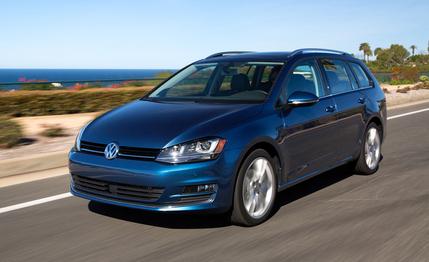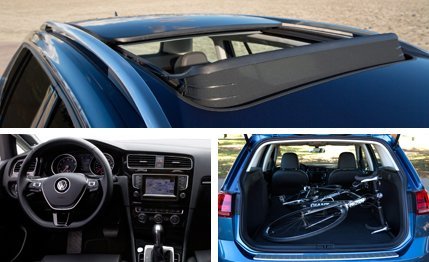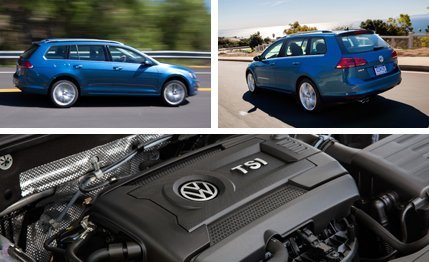
 First Drive Review
First Drive Review
It’s finally here. Two Geneva shows ago, VW first revealed the Golf SportWagen. That summer, we ran our first-drive report on the European model and started counting the days until we could get one here. Well, this much-anticipated Jetta SportWagen replacement arrives in U.S. dealerships by early April. As with the 10Best-winning Golf hatchback and GTI, the long delay was due to the wait for assembly of the North American–market model at VW’s plant in Puebla, Mexico. Our first drive in these Mexican-built wagons confirms that they’re as solid and enjoyable as any other seventh-generation Golf.
While VW’s ambitious U.S. sales targets would have a better chance of reaching fruition if Wolfsburg would send us new models as soon as they’re available in Germany, lower costs for assembly and transportation pay off in an aggressive pricing scheme for the new wagon. Despite arriving so late in the year, these SportWagens are 2015 models for a few months. The 2016 models will likely bring the addition of an all-wheel-drive version (officially: “We’re working on it”) and will definitely incorporate upgraded telematics and a built-in USB port that the 2015 edition still lacks.
VW gave us a chance to drive the U.S.-spec SportWagens in and around Austin, Texas, just as the big crowds for the SXSW confab were coming into town and clogging the major highway arteries. Fortunately, we were able to get out into the surrounding Hill Country.


Even without all-wheel drive in the mix yet, there are six SportWagen models, counting S, SE, and SEL trims available with either the 1.8-liter TSI four-cylinder gasoline engine or the 2.0-liter TDI diesel. Add the three transmissions and there are 10 configurations before you even start scanning the options list. With limited time and miles at our disposal, we opted to sample the price-leader gasoline model and a loaded-up SEL with the diesel. As with other Golfs, the TSI comes with a manual transmission only in the base S model, and that’s a five-speed unit. This runt of the litter must also endure a restriction on peak torque to 184 lb-ft versus the 199 claimed for its brethren equipped with a slushbox. All SE and SEL gasoline-burners have the six-speed automatic as standard. A six-speed stick shift is standard with every TDI. Clutchless operation costs an additional $1100 where it’s available, whether it’s the torque-converter automatic on the 1.8T or the dual-clutch DSG on diesels.
Considering its weakling status in the lineup, the base model delivers a lot of goodness for $22,215. No, you don’t get navigation or power lumbar supports or push-button start, but for those who prioritize the driving experience, the Golf’s strong foundation yields a premium feel. Adding the bigger cargo area and stiffer rear springs to accommodate the payload, plus a full foot of length and about 100 pounds of vehicular mass, doesn’t diminish the virtues of a rigid structure, tight assembly, and driver-friendly handling. We kept reaching for a sixth gear out of habit, even though we didn’t need it; at 66 mph in fifth gear, the tachometer shows the 1.8T spinning at 2000 rpm. It’s quiet and buttery in operation and the torque remains sufficient that you can climb moderate grades without shifting down. The engine’s qualities do not include thrilling high-rpm antics, anyway, and our tests show this drivetrain performs well in the standard Golf. Maybe the torque restriction would be more noteworthy if we’d folded down the back seats and loaded up the 66.5 cubic feet of cargo volume with heavy gear.
A greater deterrence to choosing this bottom-feeder might be the standard 15-inch wheels and Continental tires; if you want to shift for yourself and burn gasoline, that’s all you get from the factory. SE and SEL models offer 16-, 17-, and 18-inch choices, and even the base diesel rides on 16s. The 15-inchers yield a good ride with little road noise and the wheels are aluminum, a step up from the old Jetta’s base steel rims, but the small tire doesn’t have the turn-in bite a driver longs for when the road gets interesting. We found ourselves making mid-turn steering corrections out in the hills as the front end washed out—although we should note that heavy rains the day before left the road damp and wet in places.


Turn-in was no longer a problem when we moved into a TDI in SEL trim on 18-inch wheels. If anything, the situation inverted as the more performance-oriented (although still all-season-rated) Pirelli Cinturato P7s in size 225/40 introduced some impact harshness to the ride and could be heard hissing on rough-textured pavement. The sweet spot here for value, ride, comfort, and moderately entertaining behavior might be a TDI in the SE trim on 17s, and we’d probably go with the manual. If we’re not getting a clutch pedal, the DSG makes a good second-best alternative, but once you’ve anted up the premium for the diesel (call it $2000), the transmission’s $1100 cost might be better spent on other options or accessories.
The car we drove carried a $33,955 MSRP with $695 for the Driver Assistance package (forward-collision warning and parking assist) and $995 for the Lighting package (adaptive bixenon headlamps and LED accents), both of which we could live without but you may feel otherwise.
In size, interior ambience, and demeanor, this loaded example reminded us a lot of an Audi A4 Avant of about a decade ago—according to one VW engineer, the cargo space is greater, actually, but the rear seat tighter than it was in the former VW Passat wagon and that Avant. If and when we get the all-wheel-drive SportWagen, the similarities will be downright eerie. But try not to make us wait too much longer, VW, okay?